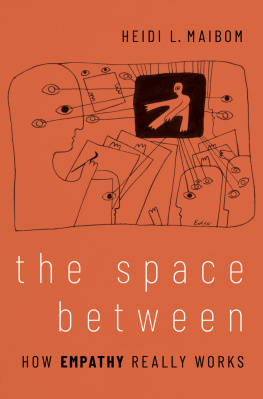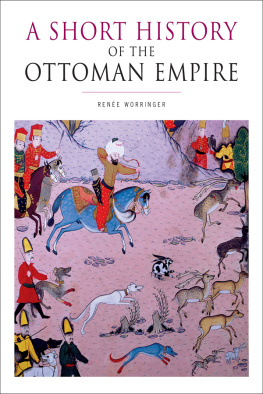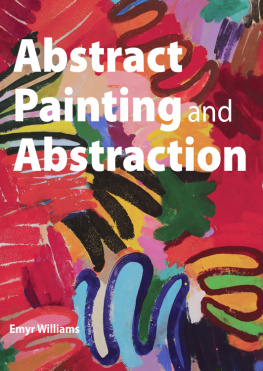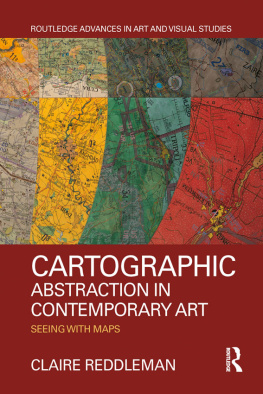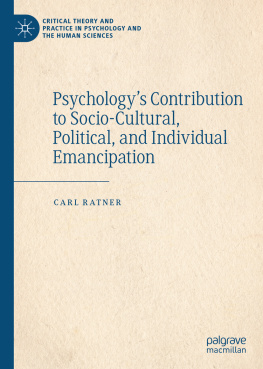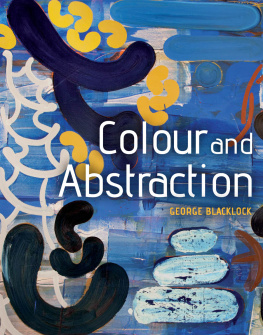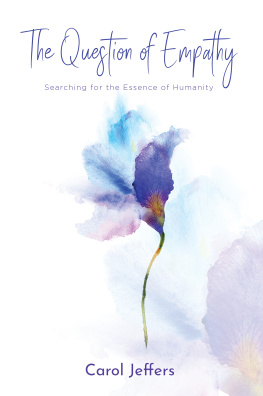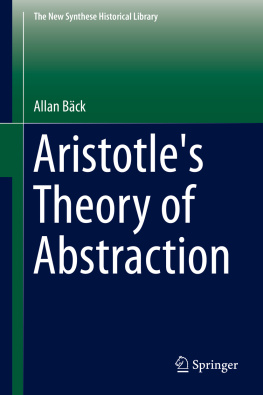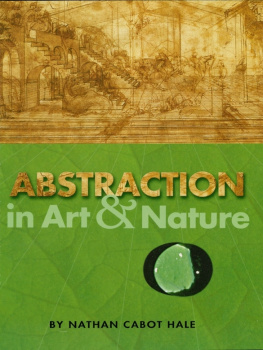Worringer - Abstraction and empathy: a contribution to the psychology of style
Here you can read online Worringer - Abstraction and empathy: a contribution to the psychology of style full text of the book (entire story) in english for free. Download pdf and epub, get meaning, cover and reviews about this ebook. City: Chicago, year: 1997, publisher: Rowman & Littlefield Publishers;Ivan R. Dee, genre: Science. Description of the work, (preface) as well as reviews are available. Best literature library LitArk.com created for fans of good reading and offers a wide selection of genres:
Romance novel
Science fiction
Adventure
Detective
Science
History
Home and family
Prose
Art
Politics
Computer
Non-fiction
Religion
Business
Children
Humor
Choose a favorite category and find really read worthwhile books. Enjoy immersion in the world of imagination, feel the emotions of the characters or learn something new for yourself, make an fascinating discovery.

Abstraction and empathy: a contribution to the psychology of style: summary, description and annotation
We offer to read an annotation, description, summary or preface (depends on what the author of the book "Abstraction and empathy: a contribution to the psychology of style" wrote himself). If you haven't found the necessary information about the book — write in the comments, we will try to find it.
Worringer: author's other books
Who wrote Abstraction and empathy: a contribution to the psychology of style? Find out the surname, the name of the author of the book and a list of all author's works by series.
Abstraction and empathy: a contribution to the psychology of style — read online for free the complete book (whole text) full work
Below is the text of the book, divided by pages. System saving the place of the last page read, allows you to conveniently read the book "Abstraction and empathy: a contribution to the psychology of style" online for free, without having to search again every time where you left off. Put a bookmark, and you can go to the page where you finished reading at any time.
Font size:
Interval:
Bookmark:
ABSTRACTION AND EMPATHY
and
EMPATHY
by
WILHELM WORRINGER
Translated from the German by Michael Bullock
With an Introduction by
HILTON KRAMER

ABSTRACTION AND EMPATHY. The special contents of this edition copyright 1997 by Ivan R. Dee, Inc. Introduction copyright 1997 by Hilton Kramer. All rights reserved, including the right to reproduce this book or portions thereof in any form. For information, address the publisher at 1332 North Halsted Street, Chicago 60622.
This book was first published in 1908 in Germany as Abstraktion und Einfhlung. It was first published in English in the United States of America in 1953 and is here reprinted by arrangement with International Universities Press. First ELEPHANT PAPERBACK edition published 1997 by Ivan R. Dee, Inc. Manufactured in the United States of America and printed on acid-free paper.
Library of Congress Cataloging-in-Publication Data:
Worringer, Wilhelm, 18811965
[Abstraktion und Einfhlung. English]
Abstraction and empathy : a contribution to the psychology of style / by Wilhelm Worringer ; translated by Michael Bullock ; with an introduction by Hilton Kramer. 1st Elephant pbk. ed.
p. cm.
Originally published: New York : International Universities Press, 1953. With new introd.
Includes index.
ISBN: 978-1-56663-177-8
1. Art, Abstract. 2. ArtPsychology. I. Title.
N7432.5.A2W6713 1997
709'.04'052dc21
97-14826
by Hilton Kramer
by Hilton Kramer
FEW DOCTORAL DISSERTATIONS have come to occupy as important a place in the history of modernist art and criticism as wilhelm worringers Abstraction and Empathy. The young German scholar, born the same year as Pablo Picasso, completed the dissertation in 1906 at the age of twenty-five. This was one year before Picasso created Les Desmoiselles dAvignon, a work with which Abstraction and Empathy shares certain interestsparticularly the interest in primitive, non-Western art forms. When the dissertation was published that year in a private edition, as academic custom required, the book excited sufficient intellectual interest in Germany for the Munich publisher Reinhard Piper to bring out a trade edition in 1908. By 1910 that edition had gone into a third printing, and by then the authors ideas about abstraction in art were the subject of intense discussion in the Munich-based Blaue Reiter circle of Franz Marc and Vasily Kandinsky.
It was not only in Germany, however, that the book found interested readers. In January 1914, by which time abstract painting was a flourishing feature of the European avant-garde, a young English poet, critic, and philosopher by the name of T. E. Hulme was introducing Worringers ideas to a London audience with a lecture on Modern Art and Its Philosophy. Hulme, who was to exert a significant influence on the early critical thought of T. S. Eliot, had met the author of Abstraction and Empathy at a conference in Berlin. He was the first English critic to recognize the books importance.
Abstraction and Empathy remained untranslated into English until 1953, yet by that time its ideas had already been introduced to American literary criticism in a brilliant essay called Spatial Form in Modern Literature by the twenty-seven-year-old Joseph Frank, who was later to achieve even greater renown for his multivolume biography of Dostoevsky. Published by Allen Tate in three consecutive issues of the Sewanee Review in 1945, Spatial Form in Modern Literature was itself instantly recognized as a classic of modern criticism. It was in that essay that I first heard of Abstraction and Empathy when I was an undergraduate in the late 1940s. It remains for me today one of the key documents in the literature of modernism.
It needs to be understood, however, that Worringer himself was not writing about modernist art in Abstraction and Empathy. He was writing about the art of the European past, but in a way that proved to be modernist in its assumptions. For it specifically called into question what, in the Foreword to the third edition of Abstraction and Empathy, Worringer described as the one-sidedness and European-Classical prejudice of our customary historical conception and valuation of art. This inquiry led him to ponder the spiritual implications of the stylistic differences that distinguished certain periods of Western art from each other as well as the even more dramatic stylistic differences that were seen to separate primitive artthe tribal art of primitive peoplesfrom, say, the tradition of Classical antiquity and the Renaissance in Europe.
In pursuit of this inquiry into what Worringer called the psychology of style, his studies took him to the great collection of ethnographical art at the Trocadro museum (now the Muse de lHomme) in Paris. This would have been some time before 1906, by which time the influence of African tribal sculpture on the art of the Fauves in France and the Brcke group in Germany was well known to the artistic intelligentsia of both countries. It is therefore hard to believe that Worringer remained unacquainted with these developmentsor, indeed, with the use that Gaugin made of the primitive art of the Pacific islands in his work even earlierduring the writing of Abstraction and Empathy. Yet nowhere in the book does its author mention them. (It may be, of course, that it was thought to be detrimental to his academic career for a young scholar to be seen to be acquainted with such unseemly developments.) Be all that as it may, it was clearly in the primitive art he studied in the then rarely visited Trocadro collection that Worringers ideas for Abstraction and Empathy were confirmedthe same collection, it is worth noting, in which Picasso later claimed to have experienced the revelation that led to the completion of Les Desmoiselles dAvignon.
Whether or not Worringer was writing out of an unacknowledged awareness of contemporary developments, or, as he claimed, in complete ignorance of the avant-garde of his time, what remains central to Abstraction and Empathy is the essential distinction it makes between art that takes pleasure in creating some recognizable simulacrum of three-dimensional spacethe real space of our waking experienceand art that suppresses that spatial illusion in favor of something flatter, more constricted and abstract. Worringer understoodas so many academicians of his time did notthat each of these approaches to art was capable of producing a certain kind of beauty, yet that each stood in a very different existential relation to the world of experience. Whereas the one not only accepted but greatly idealized that world, the other was made anxious and uncertain by it and thus felt compelled to devise artistic strategies designed to minimize its sovereignty. It was the latter that Worringer dubbed the will to abstraction.
What proved to be so timely in Abstraction and Empathy was Worringers further claim that this will to abstraction was to be understood to be one of the two fundamental aesthetic impulses known to human culturethe other, of course, being the urge to empathy which manifests itself in the naturalistic depiction of the observable world. Basing his studies on diverse cultures, styles, and periods, Worringer found the need for empathy and the need for abstraction to be the two poles of human artistic experience.... They are antitheses which, in principle, are mutually exclusive. In actual fact, however, the history of art represents an unceasing disputation between the two tendencies.
Next pageFont size:
Interval:
Bookmark:
Similar books «Abstraction and empathy: a contribution to the psychology of style»
Look at similar books to Abstraction and empathy: a contribution to the psychology of style. We have selected literature similar in name and meaning in the hope of providing readers with more options to find new, interesting, not yet read works.
Discussion, reviews of the book Abstraction and empathy: a contribution to the psychology of style and just readers' own opinions. Leave your comments, write what you think about the work, its meaning or the main characters. Specify what exactly you liked and what you didn't like, and why you think so.

